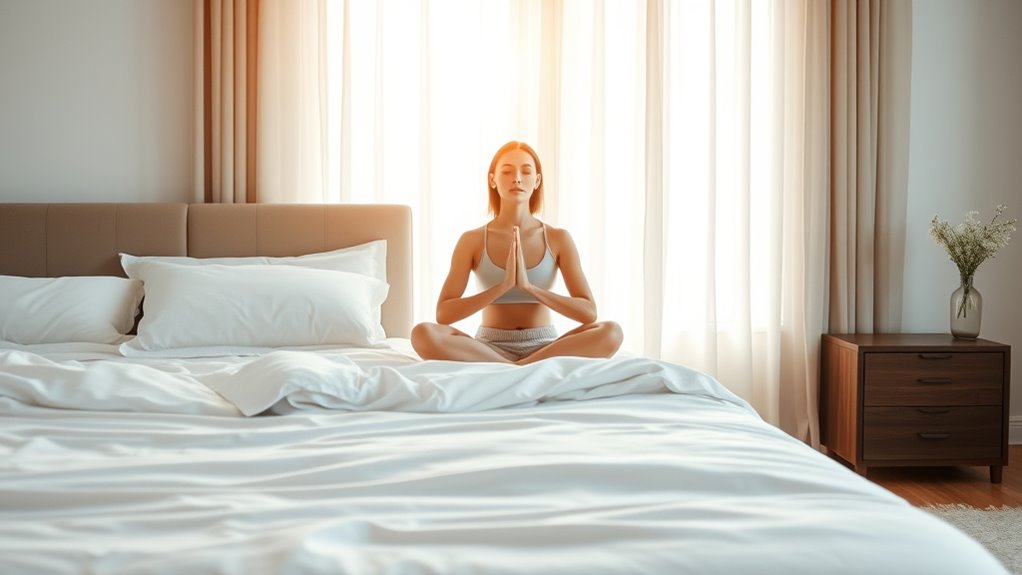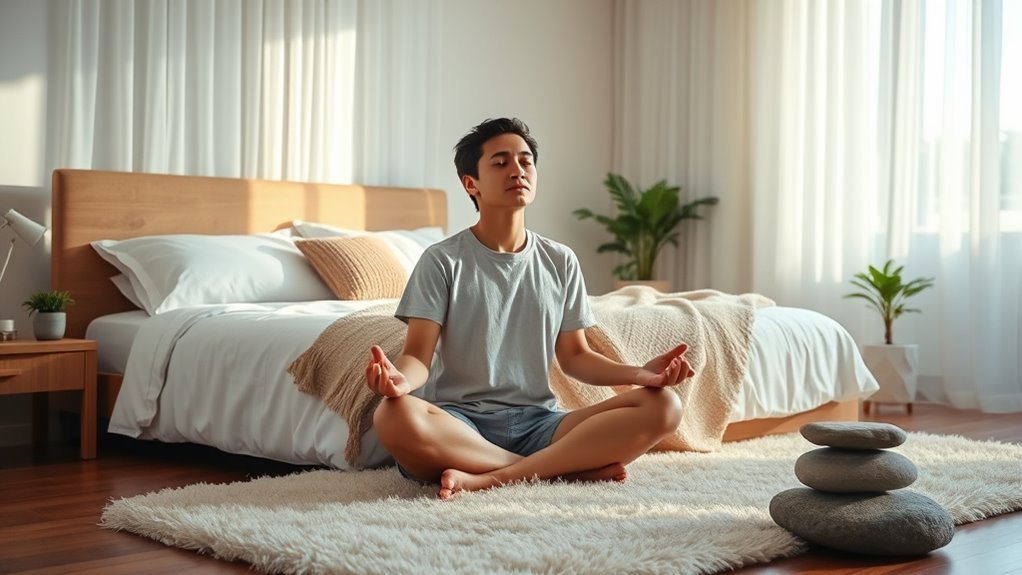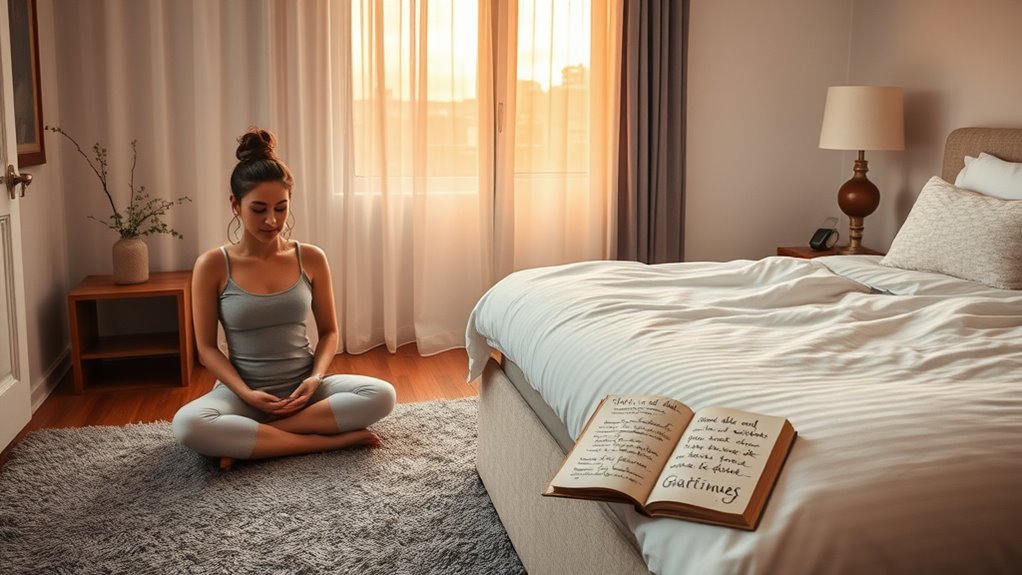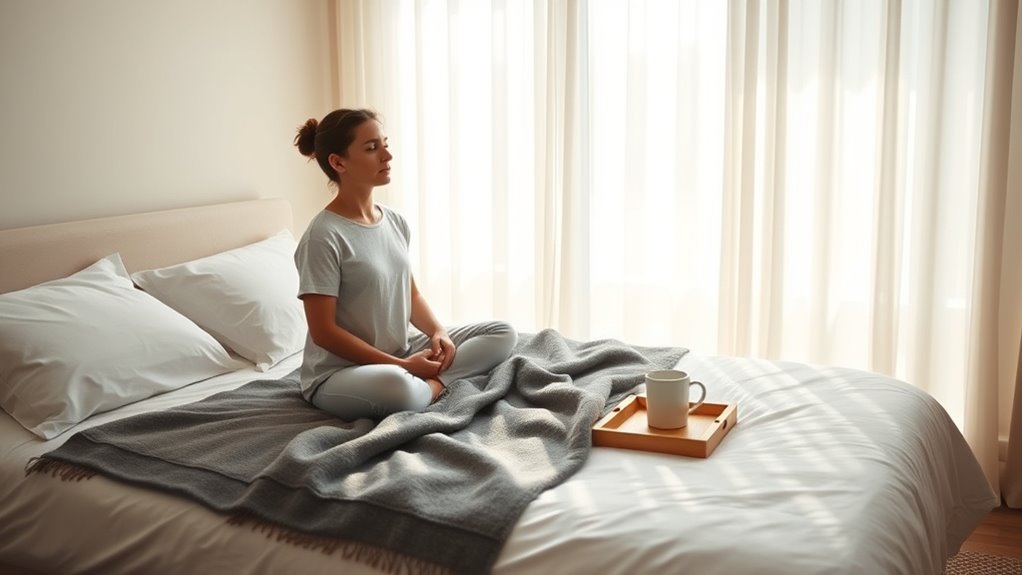To quickly practice mindfulness beside your bed, focus on deep breathing to calm your mind, inhaling and exhaling slowly. Do a gentle body scan to release tension, and notice sensations in your hands or around you. Visualize a peaceful scene or repeat positive affirmations to foster calmness. Tune into sounds nearby and appreciate quiet moments for grounding. If you keep exploring, you’ll discover even more simple ways to create a peaceful bedtime routine.
Key Takeaways
- Practice deep breathing with slow inhales and exhales to quickly center your mind before sleep.
- Perform a body scan from feet to face to release tension and promote relaxation.
- Focus on sensory details of nearby objects or textures to ground yourself in the present moment.
- Listen attentively to environmental sounds, noting their qualities without judgment to foster calmness.
- Use guided visualization of peaceful scenes combined with affirmations to quickly soothe your mind.
Deep Breathing to Center Your Mind

Have you ever noticed how a simple deep breath can instantly calm your mind? When you feel overwhelmed or anxious, take a moment to focus on your breath. Inhale slowly through your nose, counting to four. Feel your chest expand and your belly rise. Hold that breath for a moment, then exhale gently through your mouth, counting to four again. Repeat this process a few times, allowing your thoughts to settle. Deep breathing activates your parasympathetic nervous system, helping you relax and regain focus. It’s a quick, effective tool you can do anytime, anywhere—by your bed, at your desk, or even during a stressful moment. This simple exercise anchors you in the present, bringing clarity and calmness. Incorporating controlled breathing can also enhance your overall relaxation response and reduce stress levels. Practicing this regularly can help improve your mindfulness and emotional resilience over time. Engaging in consistent mindfulness practices can further deepen your sense of calm and clarity during challenging situations, especially when combined with other stress management techniques. Recognizing and utilizing angel numbers as part of your mindfulness routine can also provide additional spiritual reassurance and guidance.
Body Scan for Relaxation

A body scan helps you relax by increasing awareness of physical sensations and releasing tension. It offers benefits like reducing stress and improving sleep when practiced regularly. Guided relaxation steps make it easy to follow, even if you’re new to mindfulness. Incorporating mindfulness practices such as body scans can deepen your understanding of your emotional and physical well-being and foster a sense of spiritual fulfillment.
Body Scan Benefits
Performing a body scan can substantially enhance your relaxation by helping you become more aware of physical sensations and releasing tension. When you focus on each part of your body, you notice areas where stress is stored, allowing you to consciously let go of tightness. This process fosters mindfulness, grounding you in the present moment and reducing mental clutter. Regular practice can lower your heart rate and blood pressure, promoting overall calmness. It also improves body awareness, helping you recognize early signs of stress or discomfort. As you become more attuned to your physical state, you gain better control over your responses to stress. Ultimately, the body scan encourages a peaceful mind and relaxed body, making it an effective tool for quick stress relief.
Guided Relaxation Steps
Guided relaxation steps provide a simple yet effective way to deepen the benefits of body scanning. When you follow these steps, you give yourself permission to fully relax and become more aware of your body. Begin by finding a comfortable position beside your bed, closing your eyes if you like. Focus on your breath, noticing each inhale and exhale. Start at your feet, paying attention to any sensations or tension. Slowly move your awareness up through your legs, hips, abdomen, chest, arms, neck, and face. As you do, breathe into any tightness or discomfort, releasing it with each exhale. This guided approach helps calm your mind, release stress, and prepare you for restful sleep or a peaceful moment of mindfulness.
Mindful Hand Placement and Sensation

Focusing on your hand placement and the sensations it produces can deepen your mindfulness practice. Place your hands gently on your lap, resting palms down or up. Notice the contact points where your skin touches fabric or air. Feel the temperature, texture, and pressure. Observe how your hands move with each breath, expanding and contracting. To enhance awareness, consider this table:
| Hand Position | Sensory Focus | Effect |
|---|---|---|
| Resting palms | Texture | Grounding and stability |
| Open fingers | Temperature | Enhances alertness |
| Clasped hands | Pressure | Promotes calmness |
Engaging your sensory awareness through these touchpoints can improve your overall mindfulness and help you stay present in the moment.
Guided Visualization for Calmness

As you become more aware of the sensations in your hands, you can deepen your mindfulness practice by guiding your mind into a state of calmness through visualization. Close your eyes and imagine a peaceful place, like a quiet beach or a lush forest. Visualize yourself there, noticing the details—the gentle waves or rustling leaves. Breathe slowly and deeply, syncing your breath with the scene. Feel the serenity seep into your body, releasing tension with each exhale. Focus on the imagery, allowing it to anchor you in the present moment. This guided visualization helps calm your mind, reduces stress, and creates a sense of tranquility that can carry with you throughout your day.
Affirmation Repetition for Positivity

Repeating positive affirmations is a simple yet powerful way to cultivate a more optimistic mindset. As you lie in bed, choose a few affirmations that resonate with you, like “I am capable,” or “Today will be a good day.” Repeat these phrases slowly and intentionally, focusing on their meaning. This practice helps rewire negative thought patterns, replacing doubt with confidence. Consistently affirming your strengths boosts your self-esteem and sets a positive tone for the day ahead. Keep your tone gentle and encouraging, allowing the words to sink in deeply. Even just a few minutes of affirmation repetition can shift your mindset, fostering resilience and optimism to face tomorrow’s challenges.
Noticing Sounds in Your Environment

Take a moment to listen to your surroundings and notice the sounds around you. Try to identify different noises, whether loud or quiet, without judgment. Focus on these quiet moments to increase your awareness and stay present in the environment. Incorporating mindful listening can help improve attention span and overall well-being. Recognizing the subtle differences in sounds can also enhance your sensory perception, creating a deeper connection to your environment. Being mindful of natural environmental sounds, such as birds or rustling leaves, can further enrich your awareness and appreciation of nature. Developing an awareness of mindfulness techniques during these moments can deepen your practice and foster a greater sense of calm. Paying attention to sound quality can deepen your mindfulness practice and foster a greater sense of calm.
Listening to Surroundings
Listening to your surroundings involves intentionally tuning into the sounds around you, whether you’re indoors or outside. Focus on the different noises, letting each sound come into your awareness without judgment. Notice the layers of sound: a distant car, the hum of the refrigerator, or birds chirping nearby. This practice anchors you in the present moment, grounding your thoughts. Use the following table to guide your listening focus:
| Close sounds | Background noises | Distant sounds |
|---|---|---|
| Your breathing | Air conditioning | A siren far away |
| Footsteps nearby | Clock ticking | Children playing outside |
| Pen on paper | Soft music in the background | Wind rustling leaves |
Engage fully with each layer, appreciating the richness of your environment.
Identifying Different Sounds
Once you’ve begun to tune into the sounds around you, the next step is to actively identify and differentiate each one. Focus on isolating individual noises to deepen your awareness. Listen carefully and note each sound, such as:
- The soft hum of your air conditioner or heater
- The distant chirping of birds outside
- The ticking of a clock nearby
- The rustling of sheets or clothing as you move
Try to distinguish these sounds without judgment or labeling. Instead, observe their qualities—loud or soft, sharp or dull, persistent or fleeting. This practice sharpens your listening skills and anchors you in the present moment. With each sound, you become more aware of your environment, fostering calmness and clarity.
Focusing on Quiet Moments
When you pause to notice quiet moments in your environment, you deepen your awareness of subtle sounds that often go unnoticed. Take a few deep breaths and listen closely. You might hear the gentle hum of the refrigerator, the distant chirping of birds, or the soft rustle of sheets. Focus on these quiet sounds without judgment or distraction. Notice how they ebb and flow, creating a calming background. This simple practice helps ground you in the present moment, reducing stress and sharpening your awareness. By tuning into these subtle sounds, you cultivate a sense of peace and mindfulness that can carry you through your day. Even during the quietest moments, your environment offers a source of calm if you take the time to listen.
Gentle Stretching With Awareness

Gentle stretching with awareness is a simple yet effective way to ground yourself in the present moment. As you stretch, focus on the sensations in your muscles and joints, noticing how each movement feels. This mindfulness helps release tension and centers your mind. To practice effectively:
- Begin with slow neck rolls, feeling each vertebra move smoothly.
- Move to shoulder shrugs, paying attention to the lift and release.
- Stretch your arms overhead, noticing the elongation along your sides.
- Finish with gentle spinal twists, sensing the twist and release in your back.
Keep your breath steady and deliberate throughout. By paying close attention to each movement, you deepen your awareness and foster calmness in your body and mind. Practicing self-awareness during these stretches can greatly enhance your overall mindset and confidence.
Focused Observation of Your Bedside Items

Turning your attention to the items beside your bed offers a simple way to anchor yourself in the present moment. Pick one object—a book, a glass, or a lamp—and focus on it. Notice its color, shape, and texture. Observe how it feels if you touch it, or how it looks under the light. Take slow, deliberate breaths as you examine each detail. Avoid rushing or letting your mind wander to other thoughts. Instead, stay fully present with the item in front of you. This focused observation helps quiet your mind and brings awareness to your surroundings. Being mindful of your environment can also help identify emotional distance or signs of checked-out partners, promoting a sense of connection and clarity. Recognizing the benefits of eye patches for skincare can encourage a gentle, self-care mindset that complements mindfulness practices. Paying close attention to these small details can deepen your mindfulness practice, fostering a greater sense of calm and presence. Incorporating awareness of your air quality can also enhance your overall sense of well-being during these moments. Additionally, observing your environment mindfully can contribute to home organization by highlighting clutter or areas that need attention, creating a more peaceful space. By paying close attention to these small details, you create a calming space for mindfulness before sleep or upon waking.
Gratitude Reflection to End the Day

Ending your day with a gratitude reflection helps you shift your focus from stress to appreciation. It’s a simple way to end the day on a positive note. Start by thinking about three specific things that brought you joy or comfort today. Consider these prompts:
- Recall a moment when someone helped you or made you smile.
- Recognize an achievement, no matter how small, you accomplished today.
- Appreciate a personal trait or strength you demonstrated.
- Acknowledge something in your environment that made you feel safe or calm.
Frequently Asked Questions
Can These Exercises Help Improve Sleep Quality Over Time?
Yes, practicing quick mindfulness exercises can improve your sleep quality over time. By regularly calming your mind and reducing stress before bed, you create a more restful environment. These exercises help lower anxiety, slow your heart rate, and promote relaxation, making it easier to fall asleep and stay asleep. Consistency is key; with time, you’ll notice better sleep patterns and overall improved rest, enhancing your well-being.
Are These Mindfulness Exercises Suitable for Children or Elderly?
Did you know that over 20% of children and seniors experience sleep issues? These mindfulness exercises can be suitable for both groups, but you should adapt them carefully. Children and the elderly may need simpler techniques or shorter sessions. Always guarantee exercises are gentle and appropriate for their abilities. Consulting a healthcare professional beforehand helps optimize their safety and benefits, making mindfulness a helpful sleep aid for all ages.
How Long Should Each Exercise Session Last for Effectiveness?
For effective mindfulness exercises, aim for sessions lasting 5 to 10 minutes. You’re more likely to stay consistent and avoid feeling overwhelmed if you keep it short. Focus on your breath, sensations, or simple observations during this time. If you find it helpful, you can gradually extend your practice. The key is regularity; even brief daily sessions can profoundly improve your mental clarity and relaxation.
Can I Do These Exercises if I Have Mobility Issues?
Imagine your body as a gentle river, flowing smoothly despite occasional obstacles. If you have mobility issues, you can still navigate this flow by choosing seated or even lying down mindfulness exercises. Focus on your breath, sensations, or guided imagery. These adaptations help you stay present and relaxed without straining your body. Always listen to your limits, and consult a professional if needed, ensuring a safe, calming practice.
Are There Any Contraindications or Situations Where I Should Avoid These Exercises?
You might want to avoid certain mindfulness exercises if you have severe health issues or injuries that limit your movement or cause discomfort. Always listen to your body and stop if you feel pain or dizziness. If you’re unsure, consult your healthcare provider before starting any new practice. Mindfulness should help you relax, so avoid exercises that cause stress or strain. Prioritize safety and adapt exercises to your abilities.
Conclusion
Practicing these quick mindfulness exercises beside your bed can profoundly reduce stress and improve your sleep. Did you know that just five minutes of mindful breathing can lower cortisol levels? Incorporate these simple techniques into your nightly routine to start waking up refreshed and centered. With consistent practice, you’ll find more peace and clarity each morning. So, give it a try tonight—you deserve a calm, restful night.









